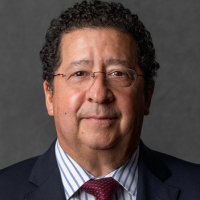Middle East Energy: Beyond an Iran Nuclear Deal
The Wilson Center’s Regional and Global Energy series continued on July 9 with a deeper look into Middle East energy and what changes could be expected in the aftermath of an Iran nuclear deal. In a diverse panel of experts from both academia and the private sector, the speakers highlighted future oil and natural gas developments in Iran, Iraq, and the Persian Gulf, as well as the broader trends of the Middle East and the global energy market.
On July 9, 2015, the Middle East Program at the Woodrow Wilson Center hosted a Wilson Center Region and Global Energy Series event “Middle East Energy: Beyond an Iran Nuclear Deal” with David Gordon, Senior Advisor of Eurasia Group; Julia Nanay, Principal of Energy Ventures LLC; Jean-Francois Seznec, Non-Resident Senior Fellow of Atlantic Council; and David Goldwyn, President of Goldwyn Global Strategies LLC and former State Department Special Envoy and Coordinator for International Energy Affairs. Andrew Selee, Executive Vice President of the Wilson Center, provided welcoming remarks. Henri J. Barkey, Director or the Middle East Program, provided introductory remarks and noted its timeliness in the context of the P5+1 nuclear negotiations with Iran. Jan H. Kalicki, Public Policy Scholar and energy lead at the Woodrow Wilson Center, opened the conversation by highlighting three significant questions: if there is a deal between Iran and the P5+1, how will lifting sanctions impact Iranian production and exports? How will Iran’s neighbors respond? And how will the deal affect broader energy trends and geopolitics?
Gordon started by noting that there were two additional key areas of focus that the world should be watching besides the nuclear negotiations with Iran: the Levant and Libya. In the Levant, the Syrian civil war has entered its fourth year, the Islamic State (IS) has created a resilient powerbase, the Syrian Kurds have managed to establish a broad zone of control along the Turkish-Syrian border, and the Turks have moved to militarize their border with Syria. Second, while Libya has experienced radical decentralization and an escalation in conflict, the country might still be able to find a solution to its political and security issues and then significantly impact the oil market. Regarding the negotiations between the P5+1 and Iran, Gordon noted that if they are successful a deal could ease tensions among the regional powers and allow for a stronger coalition to combat IS.
Nanay emphasized that timing will be key in Iran’s return to the energy market. Iran has loaded a number of cargo tankers with 30 or more million barrels of oil that can be sold as soon as sanctions are lifted. Iran is in an advantageous position to supply Europe, East Asia, and the Middle East with both oil and natural gas. However, in the Middle East, Iranian gas exports face both political and commercial obstacles, with pricing disagreements already holding up some projects. Iranian oil exports to Europe and China have been replaced since 2012 by a number of competing suppliers, including Russia and Saudi Arabia. Another key point Nanay discussed is the potential for increased Iranian natural gas in the global marketplace. Iran has the world’s largest natural gas reserves and has made significant investments in developing its offshore Pars Field, which it shares with Qatar’s cross-border North Field. However, with North American as well as other major players such as Qatar to Australia already in the market, will Iranian exports prove sufficiently competitive?
Seznec pointed out that how Saudi Arabia responds to Iran’s return to the market will have important regional and global consequences. Saudi Arabia can be expected to defend strongly its market share, resulting in lower oil prices across the board. On the one hand, this will likely encourage Iran to focus more on natural gas exports over the longer term. On the other hand, Saudi Arabia will look increasingly to adding value to its oil production through petrochemical and other investments. If political obstacles can be overcome, Iran would be well positioned to supply natural gas to the Persian Gulf. Interestingly, the Saudis and Russians have stepped up their dialogue, suggesting an interest in greater understanding on future exports, which might be extended to include Iran.
Goldwyn highlighted four key points with regard to Iraq. First, the war against IS has only further fragmented an already divided Iraq, with most of the successes coming from the Kurdish peshmerga. Second, the Baghdad-Erbil energy deal is unraveling as Baghdad fails to implement revenue sharing provisions and the Kurdistan Regional Government fails to market the requisite 550,000 barrels per day of crude oil through Bagdad’s State Organization for the Marketing of Oil (SOMO). Third, Iraq has been unable to continue to develop its reserves due to a growing shortage of cash. Fourth, Iraqi shortfalls may provide space to OPEC to make more room available for increased Iranian exports. In addition, Goldwyn observed that while Saudi Arabia has begun to show more initiative toward combatting IS, it still perceives Iranian regional ambitions as comprising the number one threat to its security. While a Saudi-Iranian security deal would be pivotal not only for the two countries but for the region as a whole, there are complex obstacles on both sides that make such an agreement challenging to reach.
By Brandon Roselius, Research Assistant
Speakers


Former Counselor for International Strategy, Chevron; Chairman, Eurasia Foundation
Hosted By

Middle East Program
The Wilson Center’s Middle East Program serves as a crucial resource for the policymaking community and beyond, providing analyses and research that helps inform US foreign policymaking, stimulates public debate, and expands knowledge about issues in the wider Middle East and North Africa (MENA) region. Read more
